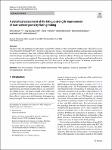Item Infomation
Full metadata record
| DC Field | Value | Language |
|---|---|---|
| dc.contributor.author | Braun, Moritz | - |
| dc.contributor.author | Baumgartner, Jörg | - |
| dc.contributor.author | Hofmann, Gloria | - |
| dc.date.accessioned | 2023-10-06T08:43:20Z | - |
| dc.date.available | 2023-10-06T08:43:20Z | - |
| dc.date.issued | 2023 | - |
| dc.identifier.uri | https://link.springer.com/article/10.1007/s40194-023-01569-5 | - |
| dc.identifier.uri | https://dlib.phenikaa-uni.edu.vn/handle/PNK/9499 | - |
| dc.description | CC-BY | vi |
| dc.description.abstract | All major rules and guidelines include fatigue design (FAT) classes for flush ground butt-welded joints. These FAT classes vary between FAT110 and FAT155; however, in the majority of cases, the underlying database and specimen-related details are unclear or unknown. This study evaluates 1003 fatigue test results gathered from various literature sources and tries to relate the fatigue strength improvement to typical specimen types and test conditions. To this goal, statistical methods based on correlation analysis are employed. Next, proposals for updates of rules and guidelines for flush ground butt-welded joints made of steel are established by determining new FAT classes and a suitable slope exponent. In addition, an overview of design standards and recommendations is given and main influencing factors are discussed. | vi |
| dc.language.iso | en | vi |
| dc.publisher | Springer | vi |
| dc.subject | FAT | vi |
| dc.subject | the fatigue strength improvement | vi |
| dc.title | A statistical assessment of the fatigue strength improvement of butt-welded joints by flush grinding | vi |
| dc.type | Book | vi |
| Appears in Collections | ||
| OER - Khoa học Vật liệu, Ứng dụng | ||
Files in This Item:

